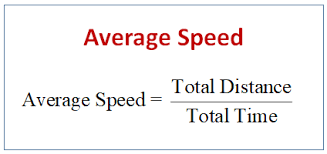
Average Speed Formula: How can we tell how fast something moves when speeds keep changing? This is where average speed helps!
Average speed shows how fast something travels over a distance, even if the speed varies during the trip. It is calculated by dividing the total distance covered by the total time taken. Whether it’s during a car journey, a bike ride, or a running race, average speed helps us understand overall motion. In this article, we will explore the average speed formula, how it works, and examples to make the concept easier to understand.What is the Average Speed?
Average speed represents how fast an object travels overall during a journey, even if its speed changes at different points. For instance, a runner completes a 10-mile race in 2 hours. During the race, the runner might sprint at certain points and slow down at others, but the average speed gives a single, simplified value to describe the overall motion. This value helps in understanding motion in a simplified way and is useful for comparing different journeys or planning travel times.What is the Average Speed Formula?
The average speed formula helps determine how fast an object moves over an entire journey. It is calculated by dividing the total distance traveled by the total time taken: Average Speed = Total Distance ÷ Total Time When an object travels at different speeds, covering various distances over separate time intervals, the formula adjusts to account for the combined motion: Average Speed = (Distance 1 + Distance 2 ) ÷ (Time 1 + Time 2 ) or Average Speed = (d + D) ÷ (t + T) Here:- d and D represent distances,
- t and T represent the corresponding time intervals.
A car travels 60 kilometers in 1 hour and then 90 kilometers in 2 hours. What is the average speed?
Total Distance = 60 km + 90 km = 150 km
Average Speed = Total Distance/Total Time
Average Speed = 150 km/ 3 hours Average Speed = 50 km/h
Factoring D out from the denominator:
v avg = 2D/Canceling D from both numerator and denominator:
v avg = 2D/D(Taking the LCM in the denominator:
v avg = 2 v v v + v Therefore, the formula for average speed when covering equal distances at two different speeds is
v avg = 2 v v v + v Example: Rohit travels from point A to B at a certain speed and returns at 56 m/s. The average speed for the entire trip is 49 m/s. Find his speed when traveling from A to B.
Solution: Let m represent Rohit’s speed from A to B, and n = 56 m/s be his speed from B to A. Using the formula: V avg = 2mn/m + n where:- V avg = 49 m/s
- m is Rohit’s speed from A to B (unknown)
- n = 56 m/s (speed from B to A)
Step 1: Substitute the values into the formula
49 = 2 × m × 56/m + 56Step 2: Cross multiply
49(m + 56) = 2 × m × 56/ m + 56Expanding both sides:
49m + 49 × 56 = 2 × m × 56 49m + 49 × 56 = 112mStep 3: Solve for m
Rearrange the equation: 112m − 49m = 2744 m = 2744/63 = 43.56 m/s Thus, Rohit’s speed from A to B is 43.56 m/s.Average Speed Formula Special Cases
The average speed formula can be applied to various scenarios, depending on how an object travels. Let’s understand Average Speed Formula Special Cases with examples below:Case 1: Speeds Over Different Time Intervals
If an object moves at different speeds over separate time intervals, the formula for average speed is:Average Speed = (s 1 × t 1 ) + (s 2 × t 2 )/ t 1 + t 2
Let's understand the concept better with the example below: A cyclist travels at 10 km/h for 2 hours and then at 20 km/h for 3 hours. What is the average speed? Solution: Substitute into the formula: Average Speed = (10 × 2) + (20 × 3)/2 + 3 = 20 + 60 /5 =16 km/h Thus, the average speed is 16 km/h .Case 2: Distances Covered Over Different Time Intervals
If an object covers different distances over various time intervals, the formula becomes: Average Speed = d 1 + d 2 + d 3 / t 1 + t 2 + t 3 +… A car covers 50 km in 1 hour , 30 km in 0.5 hours , and 70 km in 2 hours . What is the average speed? Solution: d 1 = 50 km, d 2 = 30 km, d 3 = 70 km. t 1 = 1 hour, t 2 = 0.5 hours, t 3 = 2 hours Substitute into the formula: Average Speed = 50 + 30 + 70/1 + 0.5 + 2 = 150/3.5 ≈ 42.86 km/h Thus, the average speed is approximately 42.86 km/h . General Case (n Speeds or Distances) For multiple speeds or distances, the formulas extend as: Speeds: Average Speed = (s 1 × t 1 ) + (s 2 × t 2 ) +…+(s n × t n )/ t 1 + t 2 +..... t n Distances: Average Speed =(d 1 × t 1 ) + (d 2 × t 2 ) +…+d n / t 1 + t 2 +..... t n These These cases simplify understanding motion over varying conditions, helping calculate average speed across any journey.Example 1: Ravi drove 45 miles per hour for 2 hours, 55 miles per hour for 3 hours, and 70 miles per hour for 4 hours. What was his average speed for the entire journey?
Solution:
Distance covered in the first two hours:
Distance = 45 × 2 = 90 milesDistance covered in the next three hours:
Distance = 55 × 3 = 165 milesDistance covered in the last four hours:
Distance = 70 × 4 = 280 milesTotal distance covered:
Total Distance = 90 + 165 + 280 = 535 milesTotal time taken:
Total Time = 2 + 3 + 4 = 9 hoursAverage Speed:
Average Speed = Total Distance/Total TimeAnswer: Ravi’s average speed was 59.44 miles per hour.
Example 2: A train travels from City X to City Y at a speed of 60 miles per hour, taking 6 hours. It returns from City Y to City X at a 20% higher speed. Calculate the average speed of the entire journey.
Solution:
Speed from City X to City Y: m = 60 miles/hour
Speed from City Y to City X (20% higher): n = 60 + (20% × 60) = 60 +12 = 72 miles/hours
Average Speed Formula:
Average Speed = 2 × m × n/ m + nSubstitute values:
Average Speed = 2 × 60 × 72/ 60 + 72 = 8640/132 = 65.45 miles/hour The average speed of the train for the entire journey is 65.45 miles per hour . Join Kids Online Tuition Classes Online Now!!| Related Articles | |
| Area of Rectangle | Isosceles Triangle |
| Composite Numbers | Differentiation |
| Perimeter of Rectangle | Surface Area of Cylinder |
Average Speed Formula FAQs
What is the average speed when an object moves at constant speed?
How is average speed different from instantaneous speed?
Can the average speed be zero? Why or why not?
Can the average speed be greater than the highest speed? Why or why not?
What is the difference between average speed and average velocity?









